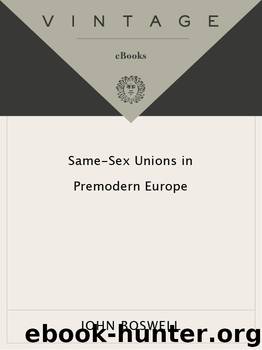Same-Sex Unions in Premodern Europe by John Boswell

Author:John Boswell [Boswell, John]
Language: eng
Format: epub
ISBN: 978-0-8041-5095-8
Publisher: Knopf Doubleday Publishing Group
Published: 2013-08-28T04:00:00+00:00
* * *
1. Cyrille Vogel, “Les rites de la célébration du mariage: Leur signification dans la formation du lien durant le haut Moyen Ăge,” in Matrimonio, 397–465, p. 426. Cf. Anne Schwerdtfeger, Ethnological Sources of the Christian Marriage Ceremony (Stockholm, 1982), 111: “It is risky to speak of ‘Christian marriage’ at this period, since there was no real distinction between the Christian and non-Christian ceremonies. It would be more correct to speak of ‘marriage among Christians’ for several centuries into the Christian era.”
2. Esther Cohen and Elliott Horowitz, “In Search of the Sacred: Jews, Christians and Rituals of Marriage in the Later Middle Ages,” Journal of Medieval and Renaissance Studies 20 (1990), 225–48, p. 231.
3. See comments by Musonius Rufus on this in Chapter 2; cf Xenophon, Memorabilia 2.2.4: “of course people do not beget children on account of sexual interest [], because the streets are full of people for that. We select for wives those who will bear us the best children, and then marry them to produce children [].”
4. Nonetheless, a provincial summary of Roman law unquestionably influenced by Christians says that “all the … laws were constituted regarding every matter so that a man could leave his goods as an inheritance to his children” (Arthur Vööbus, The Syro-Roman Lawbook: The Syriac Text of the Recently Discovered Manuscripts Accompanied by a Facsimile Edition and Furnished with an Introduction and Translation [Papers of the Estonian Theological Society in Exile, 39], [Stockholm, 1983] p. 60 §157). (The actual text of this work, though Vööbus planned to publish it, never appeared in print.) In the Theodosian Code—also an amalgam of Roman legal principles and Christian belief—the many concerns about remarriage are obviously inspired mostly by concern about the inheritance of children and the possibility that heirs of the first marriage will be disadvantaged by a second: 3.13.3, 4.6.3, 3.17.4, 8.13.1, 8.13.4, 2.21.2, 3.8.2, 3.8.3, 3.9.1, 5.1.8, and Novella Theodosiani 14.1. This concern is acknowledged frankly by John Chrysostom in De virginibus XXXVII.3.
5. For Jesus’ use of “brother,” see pp. 121–22.
6. Heb. 13:4: /Honorabile conubium in omnibus et torus immaculatus. Note that this comment follows the command to “let brotherly love continue” ( [particularly striking in the Vulgate {Caritas fraternitatis maneat in vobis}, because caritas is later used for conjugal affection, even in marriage rites]).
7. The best study of this topic is still Korbinian Ritzer, Formen, Riten und religiösen Brauchtum der Eheschliessung in den christlichen Kirchen des ersten Jahrtausends. Liturgiewissenschaftliche Quellen und Forschungen, 38 (Münster, 1962). There is a French translation (Le mariage dans les Églises chrétiennes du Ier au XIe siècle [Paris, 1970]), which is more commonly cited, and updated the German in a few particulars, but abbreviated many of the notes. Also useful are Kenneth Stevenson, Nuptial Blessing: A Study of Christian Marriage Rites (New York, 1983) (hereinafter cited as Stevenson). See also Polycarpus Radó, Enchiridion liturgicum complectens theologiae sacramentalis et dogmata et leges iuxta novum codicem rubricarum, II (Rome, 1966), and, for a later age, Jean-Baptiste Molin and Protais
Download
This site does not store any files on its server. We only index and link to content provided by other sites. Please contact the content providers to delete copyright contents if any and email us, we'll remove relevant links or contents immediately.
| African-American Studies | Asian American Studies |
| Disabled | Ethnic Studies |
| Hispanic American Studies | LGBT |
| Minority Studies | Native American Studies |
Cecilia; Or, Memoirs of an Heiress — Volume 1 by Fanny Burney(31357)
Cecilia; Or, Memoirs of an Heiress — Volume 3 by Fanny Burney(30954)
Cecilia; Or, Memoirs of an Heiress — Volume 2 by Fanny Burney(30909)
The Great Music City by Andrea Baker(21817)
We're Going to Need More Wine by Gabrielle Union(18090)
Bombshells: Glamour Girls of a Lifetime by Sullivan Steve(13122)
Pimp by Iceberg Slim(12953)
All the Missing Girls by Megan Miranda(12786)
Fifty Shades Freed by E L James(12467)
Talking to Strangers by Malcolm Gladwell(11919)
Norse Mythology by Gaiman Neil(11914)
Crazy Rich Asians by Kevin Kwan(8378)
Mindhunter: Inside the FBI's Elite Serial Crime Unit by John E. Douglas & Mark Olshaker(7854)
The Lost Art of Listening by Michael P. Nichols(6492)
Enlightenment Now: The Case for Reason, Science, Humanism, and Progress by Steven Pinker(6420)
Bad Blood by John Carreyrou(5786)
The Four Agreements by Don Miguel Ruiz(5536)
Weapons of Math Destruction by Cathy O'Neil(5058)
We Need to Talk by Celeste Headlee(4888)
